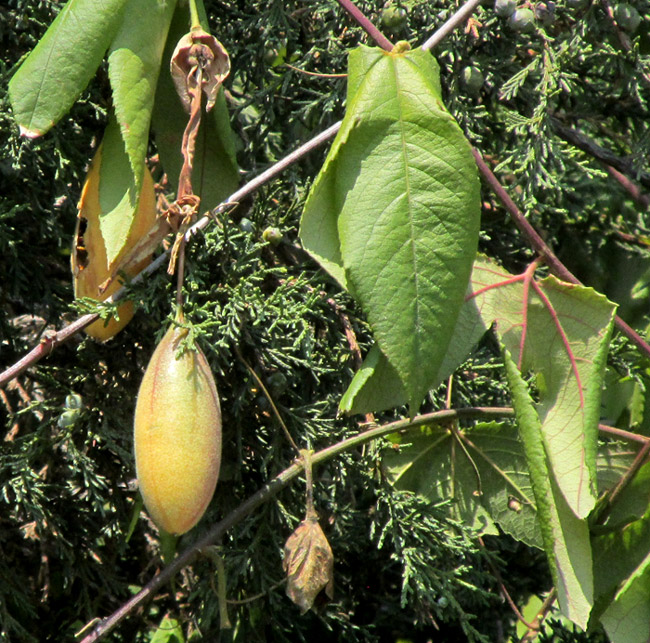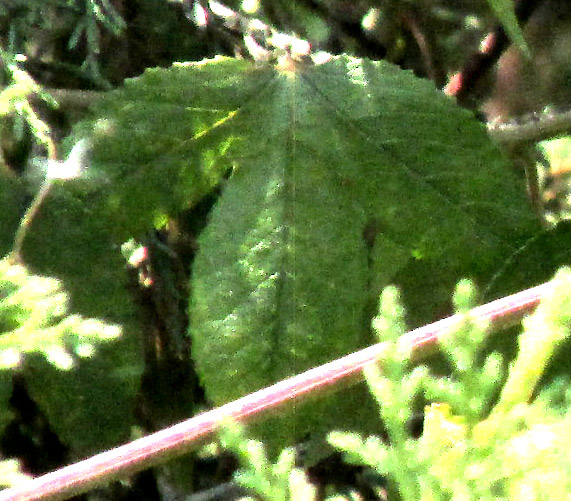Excerpts from Jim Conrad's
Naturalist Newsletter
entry from field notes dated May 6, 2023, on west side of El Bosque de las Hojas on the road connecting Hwy120 and El Doctor; oak, pine and juniper forest on limestone bedrock; elevation ±2650m (8700 ft); Eastern Sierra Madre mountains of east-central Querétaro state, MÉXICO, (N20.88°, W99.62°)
INVASIVE BANANA PASSION FLOWER IN FRUIT

After being cleared of trees, a steep, rocky slope was densely revegetating with young junipers and a few pines. Numerous leafy vines had draped themselves across the trees' tops, and I wondered what they were. The slope was very steep and fenced off, so I couldn't get close, but from the road a few details could be spotted. The camera had a modest telephoto lens, and later the pictures could be enlarged to see things better; here's one feature that turned up:

Despite the slender shape, the fruit's size, and its dangling from a vine on a long, slender stem, or stipe, suggested a passion fruit, genus Passiflora of the Passionflower Family, the Passifloraceae. Most passion fruits sold in markets are spherical and purple skinned, but over 400 species of Passiflora currently are recognized, and there's plenty of variation among them. But, lacking flowers, could this species be identified?

Above you can see that the leaves are so wilted that it's hard to determine their shapes. However, the leaves' undersurfaces are silvery with pinkish veins and the margins bear small, saw-type teeth. Also, later, by greatly enlarging a telephoto picture, the shot at the right was achieved.
On the leaf's petiole, notice the four or five wart-like bumps, which are glands. Later, for identification purposes, it would be important to know that the glands cluster near the petiole's attachment with the blade, not near the attachment point with the stem. Also, near the petiole's attachment with the blade, the blade's sides project backward a little; the base is "shallowly cordate."

By searching several pictures of the vine-covered area, eventually a leaf in deep shadows turned up hardly wilted at all, revealing its shape, shown at the left. It was like a fig leaf, deeply three-lobed, with a broad, gently curving side opposite its middle lobe.
In the upland, central Mexican region known as the Bajío, where we are, if you have a Passiflora whose leaves are three-lobed like fig leaves, with backward projecting lobes at the blade base (cordate), on petioles with noticeable glands nearer the leaf base than the stem, the mature fruits are longer than 2.5cm (1in), are yellow and more elongate than spherical, then you have Passiflora subpeltata. But...
*UPDATE: When the above photos were uploaded to the iNaturalist website, user "david_costen," a longtime cultivator and hybridizer of passion-vine flowers, recognized that our vine was an invasive not included in the 2004 Flora del Bajío, the Banana Passionfruit, PASSIFLORA TERMINIANA, described by "david_costen" as an introduced Andean species clearly escaped from cultivation. He said that about 300 observations of the species in Mexico have been registered, so apparently the species is well established in Mexico, at least in high elevation temperate regions. It's native to the Andean realm of Bolivia, Colombia, Ecuador, Peru and VVenezuela.
I read that the fruits' seeds are dispersed by birds an other animals such as pigs and foxes who eat the fruits.